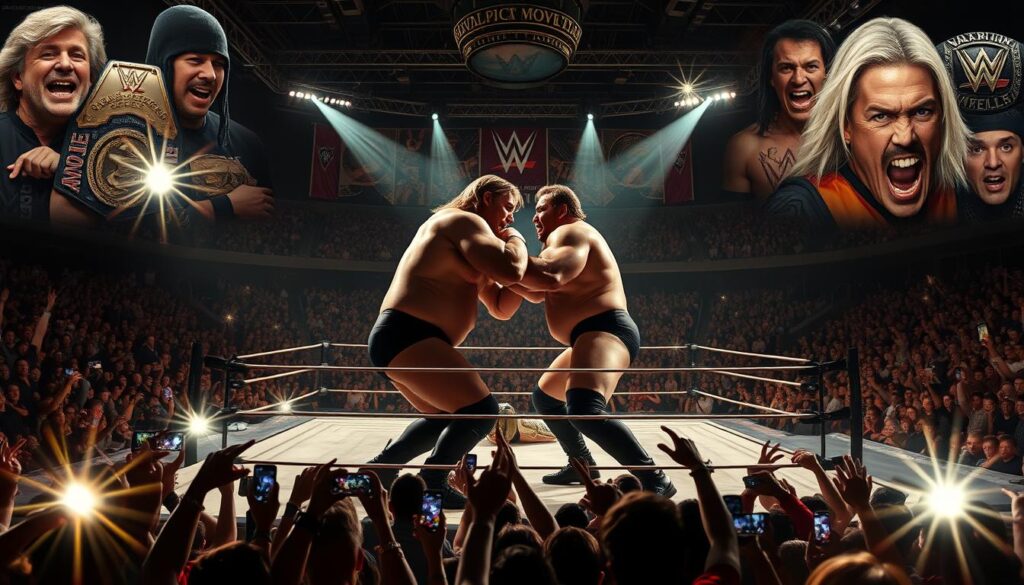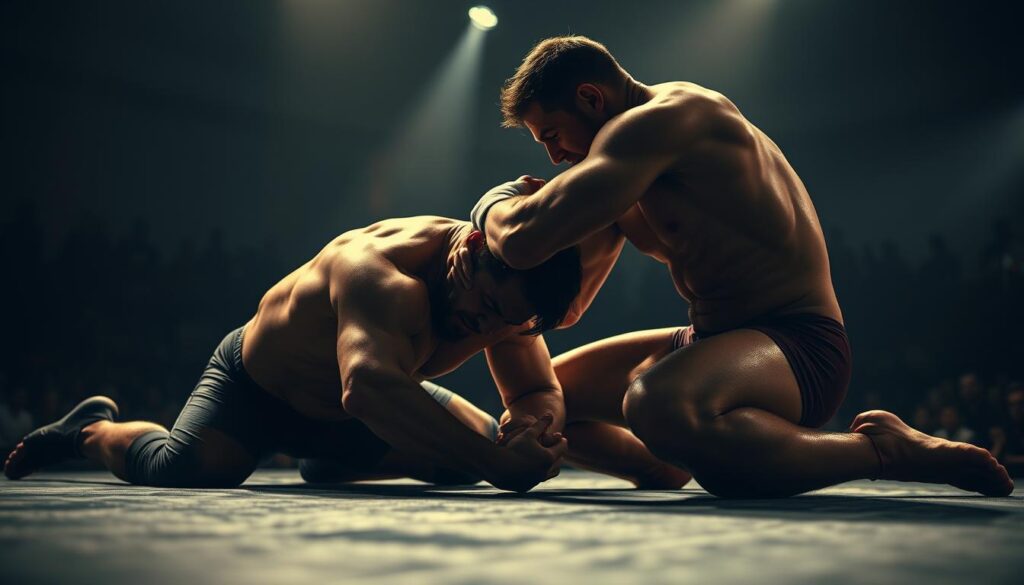Let’s be clear: Wrestling isn’t fake. Not really. The sweat? Real. The folding-chair concussions? Alarmingly authentic. But the true magic lies where choreography collides with raw human electricity – those moments when scripted spectacle bleeds into cultural reset. Think Shakespearean power plays with more spandex and fewer iambic pentameters.
Take Hogan vs. Savage. On paper, a cartoonish clash of egos. In practice? A masterclass in blurring fiction and reality. Their WrestleMania V showdown didn’t just crown a champion – it exposed the Game of Thrones-level politics simmering beneath sequined capes. The crowd didn’t cheer moves; they roared at the meta-narrative of two titans weaponizing their actual disdain.
Then there’s the Montreal Screwjob – wrestling’s JFK assassination moment. Bret Hart’s unscripted fury, Vince McMahon’s corporate poker face, and 15,000 fans realizing they’d witnessed something HBO couldn’t script. It wasn’t just a match finish; it was the birth of modern wrestling’s antihero era.
These aren’t just “sports entertainment” footnotes. They’re tectonic shifts in how we consume conflict – boardroom betrayals with body slams, retirement swan songs that spark more conspiracy theories than a Kubrick film. The ring ropes? Merely suggestion. The impact? As permanent as Flair’s… well, let’s save that for later.
The Mega Powers Explode: Hogan vs. Savage
Before Kardashian dramas or Real Housewives meltdowns, wrestling delivered the ultimate proto-reality TV spectacle: Hulk Hogan and Randy Savage tearing apart their friendship like two sunburnt gods fighting over a bottle of hair bleach. This wasn’t just a match – it was Dynasty with body slams, a Shakespearean tragedy set to the synth-heavy soundtrack of 1980s America.
The collision course began with Elizabeth – wrestling’s original damsel in distress – caught between Hogan’s golden-boy heroics and Savage’s paranoid machismo. Their feud anticipated reality TV tropes by decades: Imagine The Bachelor if roses were replaced with folding chairs and the final rose ceremony happened atop a steel cage. For those craving the full breakdown, Peacock’s definitive analysis of The Mega Powers reveals how Savage’s promos became the Rosetta Stone for modern trash-talk.
Let’s break down why this remains a wrestling milestone:
- Savage’s “Cream of the Crop” rant – equal parts wrestling promo and Nas-level diss track
- Hogan’s WCW power plays foreshadowing corporate politics
- The Elizabeth factor – wrestling’s first viral “choose your side” moment
The match itself was pure 80s excess: spandex stretched to its molecular limits, sweat glistening under hot arena lights like liquid charisma. But beneath the spectacle lay genius psychology. Savage’s twitchy paranoia vs. Hogan’s grinning entitlement created tension so thick you could spread it on toast. It wasn’t just about titles – it was about who got to define masculinity in the Reagan era.
Modern fans might smirk at the neon-soaked theatrics, but here’s the twist: This feud birthed the blueprint for today’s “reality era” wrestling. The Mega Powers didn’t just explode – they detonated a cultural atom bomb whose fallout still colors every WWE love triangle and AEW grudge match. The real question? When will Hollywood finally greenlight the Mega Powers: The Musical we all deserve.
The “Montreal Screwjob”: A Real-Life Drama
If Watergate taught us to question politicians, the Montreal Screwjob taught us to distrust wrinkled billionaire promoters clutching walkie-talkies. November 9, 1997, became wrestling’s JFK assassination moment – complete with conspiracy theories, forensic match analysis, and McMahon’s smirk replacing the grassy knoll. This wasn’t just a swerve – it was corporate theater so brutal, it made HBO’s Succession writers scribble notes like groupies at a Springsteen concert.
The setup was pure Shakespeare: Bret Hart, Canada’s golden boy, refusing to drop the WWE Title on his way to WCW. McMahon’s solution? “Let’s make it look real” became “Let’s make it BE real”. As Hart writhed in Sharpshooter agony, the Montreal crowd’s confusion turned to rage – their hero had been gaslit live on PPV. McMahon’s post-match backstage strut? That’s your Citizen Kane origin story for the Mr. McMahon character, capitalism’s id personified.
“This wasn’t business. This was personal.”
The fallout redefined wrestling’s reality era before it existed. Hart became the Edward Snowden of suplexes, leaking backstage truths in tell-all interviews. McMahon? He turned corporate villainy into performance art, perfecting techniques that would later fuel:
- Tech startup exit strategies (“We’re pivoting!”)
- Political smear campaigns (“Alternative facts”)
- Reality TV producer playbooks (“You’re fired!”)
What makes this wrestling milestone endure? It’s the ultimate Rorschach test. Marks see betrayal. Smarts see brilliant kayfabe 2.0. Cultural critics? They see America’s love affair with authentic artificiality – where we’ll forgive any sin if the story’s good. Twenty-six years later, we’re still debating: Was this wrestling’s greatest work… or its original sin?
Cultural Impact of Iconic Moments
Wrestling isn’t just spandex and suplexes—it’s America’s id doing a moonsault off the top rope. When Stone Cold Steve Austin flipped off Vince McMahon in 2001, he wasn’t just selling tickets. He was blueprinting the anti-establishment rage that would later fuel Occupy Wall Street. That middle finger? Consider it the original meme template.
Take the Undertaker’s WrestleMania streak. Like DiMaggio’s 56-game hit record, it became mythology—a sacred statistic in an era of hot takes. Then there’s ECW’s chair-throwing chaos, which didn’t just break rules—it predicted internet culture’s love affair with controlled chaos. (Yes, TikTok challenges owe Sandman a royalty check.)
Even crossover stunts like Robocop saving Sting in 1990 weren’t just campy fun. They mirrored Hollywood’s obsession with IP mashups decades before Marvel’s Avengers assembly line. And Trump taking a Stone Cold Stunner in 2007? A political Rorschach test—was it satire, prophecy, or proof that reality TV and kayfabe share DNA?
These moments stick because they’re cultural hyperlinks—click them, and you’ll download America’s subconscious. Wrestling doesn’t just reflect the zeitgeist. It body-slams it through a table.
How Wrestling Matches Influenced Pop Culture
Wrestling’s fingerprints smudge everything from TikTok dances to Hollywood blockbusters – a cultural heist so seamless even Ocean’s Eleven would tip their hats. Take Rhea Ripley’s gothic-ringleader aesthetic: her fishnet-and-leather swagger didn’t just dominate WrestleMania – it became Gen Z’s unofficial uniform, proving legendary wrestling events double as fashion runways. Meanwhile, The Rock’s eyebrow raise evolved from WWE schtick to viral meme fuel, with 12 million TikTokers now mimicking that signature smugness.
This cross-pollination turns brutal. Mick Foley’s Cactus Jack persona – a man who wrestled thumbtacks for fun – directly inspired Johnny Knoxville’s Jackass stunts. As Foley once growled:
“If you’re not bleeding, you’re not trying.”
Hollywood took notes. Rey Mysterio’s lucha libre mask? It’s the prototype for every MCU hero’s identity-concealing headgear. (Sorry, Iron Man – your faceplate owes royalties to WCW.)
WWE’s product placement makes Marvel’s cinematic universe look subtle. Remember when Stone Cold chugged Coors Light mid-match? That wasn’t just beer – it was a $50M marketing masterclass. DX’s 1998 “invasion” of a military base? A PR stunt so audacious it predated YouTube activism by a decade.
Wrestling’s Greatest Cultural Heists
| Wrestling Moment | Pop Culture Ripple | Year |
|---|---|---|
| ECW Chair Toss | Inspired UFC cage-side seat marketing | 1995 |
| Rocky Maivia’s Debut | Paved way for wrestler-turned-actor pipeline | 1996 |
| Shockmaster’s Debut | Became “so bad it’s good” benchmark | 1993 |
These historic wrestling matches didn’t just entertain – they rewired how we consume rebellion. ECW’s anarchic chair shots became protest art. The Undertaker’s entrance pyrotechnics? Basically a blueprint for Beyoncé’s Coachella set. As explored in our deep dive on wrestling’s cultural influence, the squared circle remains society’s funhouse mirror – distorting reality until the absurd becomes irresistible.
Even wrestling’s fails shape culture. Shockmaster’s glitter-helmet pratfall (1993) birthed the “so bad it’s good” entertainment genre – a legacy stretching from The Room to TikTok cringe compilations. Because in wrestling, as in life, there’s no such thing as bad publicity – just future meme material.
Technical Brilliance and Storytelling Combined
What if I told you Bret Hart’s 1992 Summerslam showdown with The British Bulldog was less about bodyslams and more about rhythm? Picture this: Hart’s technical precision unfolding like Coltrane’s saxophone solos – every wristlock a syncopated note, each reversal a call-and-response riff. This wasn’t just grappling. It was jazz improvisation with elbow pads.
Then came Shawn Michaens’ ladder match against Razor Ramon. Forget steel chairs – their 1994 clash weaponized Joseph Campbell’s monomyth. Michaels’ climb became the hero’s journey in spandex, each rung a trial testing his ring psychology. The payoff? A crucifixion pose atop the ladder that would make Renaissance painters weep.
Modern classics like Omega vs. Okada (2017) take it further. Their 47-minute epic flows like Scorsese’s tracking shots – seamless transitions between holds creating narrative momentum. You’re not watching moves; you’re seeing cinematic storytelling through dropkicks.
Here’s the hot take no one asked for: German suplexes are wrestling’s iambic pentameter. Five-count rhythm, structured yet explosive – Shakespeare would’ve booked them as finishing moves. These matches prove something radical: body slams can be high art when executed with intention.
Analysis of Match Psychology
The wrestling ring isn’t just a battleground—it’s Broadway for brute force, where every headlock whispers secrets and every pinfall screams subtext. Historic wrestling matches aren’t won through strength alone but through the artistry of emotional manipulation. Take Stone Cold Steve Austin’s 1997 WM13 bloodbath against Bret Hart: a masterclass in method acting where crimson became character development. This wasn’t violence—it was visceral poetry.
Triple H’s 2001 quad tear during a match? A Greek tragedy in sweatpants. The Game didn’t just wrestle through injury—he weaponized agony, turning a biological disaster into storytelling gold. Every limp became a plot twist, every grimace a soliloquy. Fans didn’t see torn muscle—they saw wrestling milestones being carved from sheer willpower.
Then there’s The Rock’s eyebrow. Yes, the eyebrow. That millimeter-raising flex before delivering a People’s Elbow wasn’t just sass—it was Shakespearean foreshadowing. Non-verbal cues transformed body slams into sonnets, proving wrestling psychology thrives in the spaces between moves.
Consider Undertaker’s “Old School” rope walk—a 30-second ritual that’s part intimidation, part existential crisis. Why slowly traverse ropes when you could just hit someone? Because the Deadman wasn’t selling moves—he was selling mortality. Each step asked audiences: “Do you believe in magic… or just gravity?”
“The best matches make you forget there’s a script—even when you’re holding one.”
These moments reveal wrestling’s dirty little secret: the real drama happens behind the eyes. From Austin’s defiant crimson sneer to Triple H’s accidental heroism, the greatest wrestling milestones aren’t about what’s choreographed—they’re about what’s felt. The ring becomes a Rorschach test where we project our own struggles onto body slams.
Audience and Wrestler Perspectives
In the electric dance between kayfabe and reality, wrestling’s heartbeat pulses through both the ring and the stands. The magic isn’t just in the piledrivers—it’s in the wrestling milestones where performers’ truths collide with crowd mythology. Take Bret Hart’s infamous WrestleMania 13 submission: while fans erupted at the crimson-masked heroics, backstage whispers revealed a star grappling with creative stagnation. Art imitated life, but whose life exactly?
Eddie Guerrero’s “Lie, Cheat, Steal” persona became a masterclass in blurred boundaries. His on-screen antics mirrored real battles with addiction and redemption—a scripted caricature that felt uncomfortably authentic. Crowds didn’t just cheer the character; they willed the man behind it to survive. When does a gimmick stop being fiction and start being therapy?
The 1997 Montreal Screwjob crystallized this duality. While Vince McMahon plotted backstage, the live crowd’s visceral boos foreshadowed modern digital outrage. That Quebec arena was proto-Twitter—a raw, unfiltered hive mind screaming into the void. As Bret Hart spat on the canvas, fans tasted betrayal’s metallic tang. The aftermath?
“You could smell the shock like burnt popcorn. That crowd reaction rewrote the rulebook on what ‘real’ meant in wrestling.”
Yet not all legendary wrestling events leave celebratory scars. Owen Hart’s 1999 tragedy serves as gut-punch reminder: beneath the spandex and storylines, real bodies break. The Kansas City crowd’s confusion—cheers dying mid-air as the broadcast cut to commercial—created horror movie whiplash. In that moment, kayfabe’s curtain tore completely.
| Event | Wrestler Lens | Fan Experience | Cultural Echo |
|---|---|---|---|
| Montreal Screwjob | Career betrayal | Collective outrage | Blueprint for viral controversy |
| Owen Hart Fall | Industry safety failures | Traumatic whiplash | Entertainment ethics debates |
| Guerrero’s Redemption | Personal demons | Cathartic celebration | Mental health awareness |
These wrestling milestones reveal an uncomfortable truth: the industry’s greatest stories often happen to performers, not because of them. Crowds don’t just witness history—they become co-authors through cheers, memes, and collective memory. But at what cost? The same audience that chanted “ECW” in 1995 now tweets “AEW” hot takes, forever chasing that primal rush of almost-real drama.
Legacy and Lasting Influence
What do reality TV villains, influencer rants, and drag queen runway shows have in common? They all owe royalties to wrestling’s playbook. The squared circle didn’t just create cultural earthquakes – it built the fault lines modern pop culture still trembles on.
Consider WrestleMania I’s 1985 gamble: merging rock music with body slams. That blueprint now fuels Coachella’s brand collabs and TikTok’s algorithm. Hogan’s 1996 nWo heel turn? Reality producers still use its “shock betrayal” formula like holy scripture. And Ric Flair’s sequined robes didn’t just dazzle arenas – they became drag culture’s North Star, proving extra is always enough.
The Attitude Era’s chaos perfected audience manipulation years before Twitter metrics existed. Stone Cold chugging beers? Proto-viral content. The Rock’s catchphrases? Early-stage meme warfare. As this definitive ranking of wrestling’s greatest spectacles shows, every “worked shoot” from CM Punk’s pipe bomb to MJF’s tirades follows wrestling’s playbook for raw authenticity.
Here’s the twist: Vince McMahon out-Disney’d Walt himself. While mouse ears symbolize childhood wonder, WWE’s logo represents adult rebellion repackaged as merchandise. Both empires built universes where fiction feels real – but only one made villains you secretly root for.
From steel cage matches to Starbucks collabs, wrestling’s DNA now lives in boardrooms and Instagram feeds. The real three-count? Our collective willingness to keep playing along.
Unfinished Business in Wrestling’s Eternal Drama
We’ve barely scratched the mat’s surface of wrestling’s layered mythology. The history of WWE reveals how legendary wrestling events become cultural time capsules – each piledriver and promo cutting through eras like Stone Cold shattering glass. From Bruno Sammartino’s record reign to The Rockers’ gravity-defying splits, these historic wrestling matches aren’t mere entertainment. They’re hieroglyphs documenting society’s shifting obsessions.
Next week’s deep dive pulls back the curtain on territories-era carny wisdom and AEW’s data-driven revolution. We’ll dissect why Vince Russo’s WCW tenure makes Chernobyl look like minor workplace mishap. Prepare for forensic analysis of Mae Young’s infamous “hand birth” angle – the Citizen Kane of wrestling absurdity that somehow birthed three sequels.
True believers know the real drama lives between the scripted spots. What psychological alchemy makes audiences cheer a 300-pound man jumping off steel cages? How do wrestlers turn fake punches into Shakespearean soliloquies? The answers lie where kayfabe meets quantum physics – and we’ve got front-row tickets to the collision.
Stay locked in. The bell’s just ringing for round two of our wrestling odyssey, where we’ll prove that understanding a Rock Bottom requires equal parts Newtonian physics and Freudian analysis. The squared circle never stops turning – best keep your eyes on the ropes.


